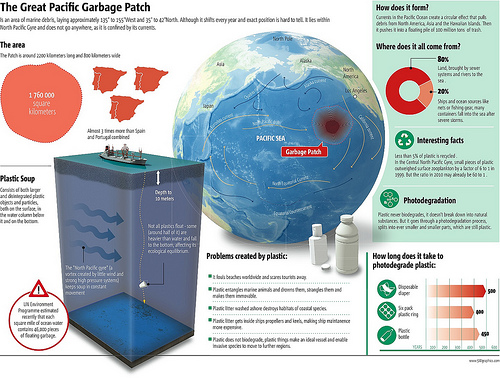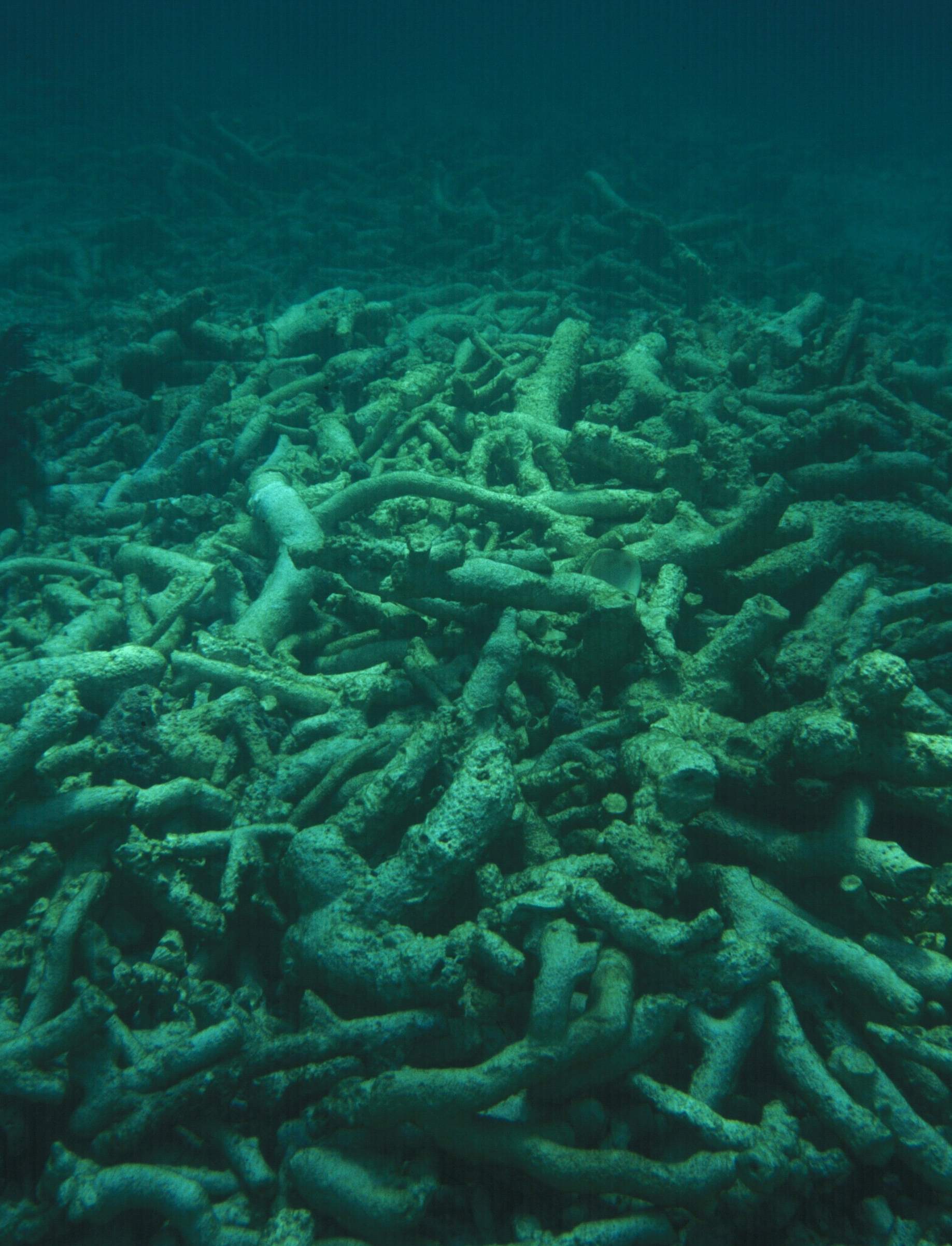Oct 04 2009
Somoa Tsunami Wave Animation
NOAA Video Animation of the Somoa Tsunami showing the wave spread across the Oceans.
Oct 04 2009
NOAA Video Animation of the Somoa Tsunami showing the wave spread across the Oceans.
May 02 2009
I’ve written about the Great Pacific Garbage Patch in the Pacific. There’s some much plastic there, that plastic outnumber plankton. Here’s an excellent infographic showing how big it is (the size of Texas), how it was created and how it’s sustained. Ocean currents from all over the Pacific push plastic dumped into waterways and off boats into the North Pacific Gyre (home of the great Pacific Garbage Patch). I was shocked when traveling to remote island in Indonesia to see their beaches covered in plastic debris.
There’s now talk of an Atlantic Garbage Patch and concern that marine fish and mammals are consuming much of the plastic (story on National Geographic).
If you’re looking for a good reason to cut down on plastic consumption, here’s an excellent one. Link to larger graphic on Flickr. Share this!

Great Pacific Garbage Patch
Most Popular Posts:
Clark Little’s Stunning Images of Waves
Your Risk of Dying of a Shark Attack
Mar 13 2009
Mavericks may be the only surf break that survives the sea level rise from global warming. Sure there will be new breaks that fill in, but my guess is that landowners won’t cede their land easily to the sea level rise. So we’ll have levees and seawalls all over the coast and basically be left with no beach. (SF Gate)
Scientists worldwide forecast that sea levels will rise for centuries even if greenhouse gas emissions are halted immediately.
The study was conducted by the internationally known Pacific Institute, a nonprofit research group in Oakland, and was paid for by the California Energy Commission, Caltrans and the state Ocean Protection Council.
With California leading the nation in regulating greenhouse gas emissions, Gov. Arnold Schwarzenegger in 2005 ordered state agencies to form a Climate Action Team to research and plan for global warming. Three dozen studies are expected this year, on air quality and health, frequency of wildfires, the use of energy and fresh water supplies.
“No other state has done this kind of assessment of coastal risk,” said Peter Gleick, president and founder of the Pacific Institute and a leading water expert. The new assessment, he said, puts the state “far ahead in our ability to both identify possible impacts and implement effective policies to prevent them.”
Although large sections of the Pacific Coast are not vulnerable to flooding, sea-level rise is expected to accelerate erosion, resulting in a loss of 41 square miles of the coast and affecting 14,000 people, the study said.
Mar 02 2009
No, not surf news. But two cool stories from National Geographic last week. A man caught the largest freshwater fish in the world, a freshwater stingray in the Mekong River in Thailand. The stingray weighed between 550 and 990 lbs (250 to 450 kilograms). The stingray’s body measured 6.6 feet (2 meters) wide by 6.9 feet (2.1) meters long. The tail was missing. If it had been there, the ray’s total length would have been between 14.8 and 16.4 feet (4.5 and 5 meters).
The Monterey Bay Aquarium Research Institute (MBARI) photographed for the first time a surreal fish with a transparent head. With a head like a fighter-plane cockpit, a Pacific barreleye fish shows off its highly sensitive, barrel-like eyes–topped by green, orblike lenses–in a picture released today but taken in 2004. The fish is the first specimen of its kind to be found with its soft transparent dome intact. The 6-inch (15-centimeter) barreleye (Macropinna microstoma) had been known since 1939–but only from mangled specimens dragged to the surface by nets.
Most Popular Posts:
Incredible HD Footage of Surfer in the Barrel
Clark Little’s Stunning Images of Waves
Diver Fights and Kills 12 ft. Tiger Shark (Photos)
Feb 10 2009

When ocean temperatures rise as they have slowly over the past couple of decades, coral is affected and often dies (coral bleaching). However, a recently discovered consequence of global warming is the gradual acidification of the oceans, which has far greater and devastating effects. As CO2 levels rise in the atmosphere, the oceans absorb up to half of it. This causes a drop in the pH of the oceans or acidification. The organisms that make coral work in a very narrow range of pH. As the oceans acidify, not only does it cause coral to stop being made, it also destroys existing coral. BBC reports. More here.
Goodbye Uluwatu, G-Land, Lance’s, and pretty much every perfect wave you can imagine. Gone. Gone also is the Great Barrier Reef and the vast ocean life the reef supports.
“The researchers warn that ocean acidification, which they refer to as “the other CO2 problem”, could make most regions of the ocean inhospitable to coral reefs by 2050, if atmospheric CO2 levels continue to increase. ”
“It’s not just the fact that something like a third of all reef-forming corals are threatened, but that we could be facing the loss of large areas of these ecosystems within 50 to 100 years.”
The new analysis shows that before 1998, only 13 of the 704 coral species assessed would have been classified as threatened. Now, the number is 231
Jan 28 2009
A mass of plastic in the Pacific, increasing tenfold each decade since 1945, is now the size of Texas and killing everything in its wake. Currently, there is six times more plastic than plankton floating in the middle of the Pacific. (Link to Article) The plastic is poisoning our fish and sealife and killing the Oceans. The plastic passes along toxins to humans through fish we eat.
– Each day, North Americans throw away more than 385,000 cellphones and 143,000 computers— electronic waste is now the fastest-growing stream of garbage. Lead and mercury are seeping from this waste into ground water. Some of the e-waste, however, is winding up in the sea.
– Each hour, North Americans consume and discard about 2.75 million plastic water and soda bottles; that’s 24 billion a year.
– Globally, 100 million tonnes of plastic are generated each year and at least 10 per cent of that is finding its way into the sea.
– Worldwide, each year 113 billion kilograms of small plastic pellets called nurdles–the feedstock for all disposable plastics– are shipped and billions are spilled during transfer in and out of railroad cars. Those spilled nurdles are ending up in gutters and drains and eventually carried into the ocean. Nurdles resemble fish eggs or roe. Tuna and salmon feed on them indiscriminately. Around 2.5 billion humans eat fish regularly. Plastic and other man-made toxins are polluting the global food chain and it’s rising at an unprecedented rate.
– Each year, a million sea birds and 100,000 sharks, turtles, dolphins and whales die from eating plastic.
Oceanographers and conservation biologists believe the only way to contend with the Great Pacific Garbage Patch is to slow the amount of plastic flowing from the land to the sea.
Buy six organic cotton shopping bags. Use them instead of supermarket plastic bags. Make it a habit to return those bags to the trunk of your car after unpacking groceries.
Reuse your plastic water bottles. If you can refill one bottle for a day then why not attempt it for a week.
See Other Amazing Posts:
The Most Amazing Photos You’ll Ever See of Waves
Diver Fights and Kills 12 ft. Tiger Shark (Photos)
Nov 18 2008
Our seas have been dying, for a long time. 90% of the world’s fisheries are imperiled, and things are only going to get worse. Though seemingly innocuous, farm-raised fish are often one of the worst environmental offenders (story in NYT). Wild-caught tuna fisheries are one of the most imperiled, but the ubiquitous sushi delight harbors consumer dangers with often toxic mercury levels (article). The picture is bleak, but there are relatively simple steps consumers can take to influence the market. This article outlines some of the scary facts about fisheries as well as the simple steps consumers can take.
Here are some quotes from the article: